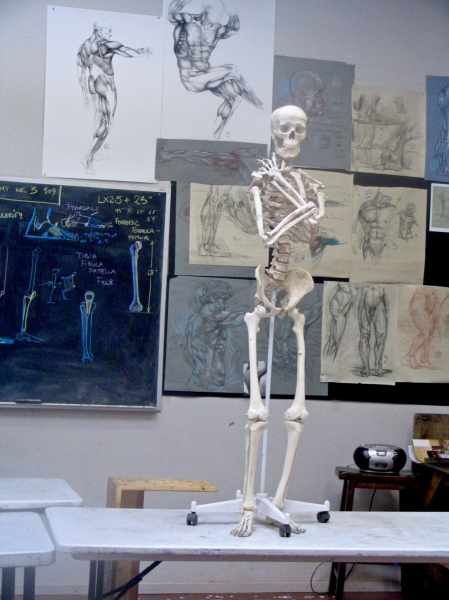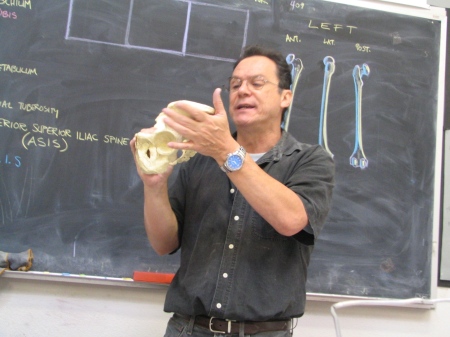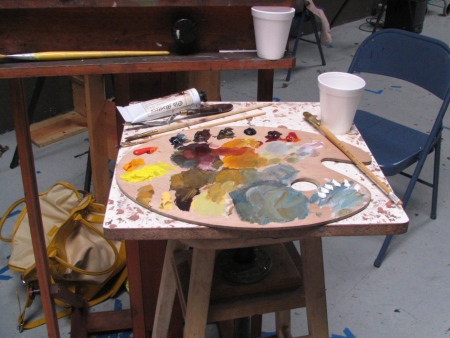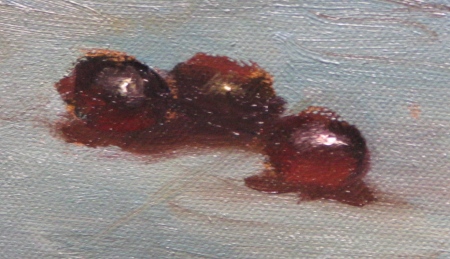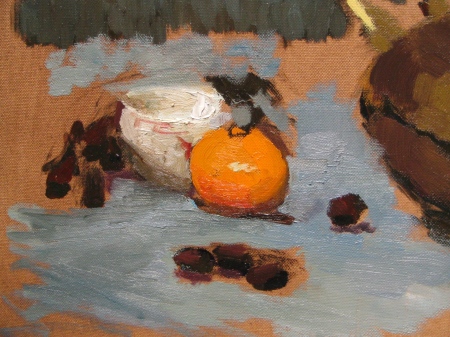Sang Bang is a Los Angeles figurative artist. He also teaches, in so many places that LAAFA, the Art Center and OTIS are by no means an exhaustive list. Sang has a blog at paulaesthete.blogspot.com, and he taught us two awesome Head Drawing classes last month.
Sang’s approach is what I think of as recipe-based. To make a nose, Sang says, do this. And to make an eye, do this. And if you do, you get a nose or an eye, and it’s not very hard at all! I love his practicality. It’s all very well to shroud art in kung-fu-like mystery, and demand that your students suffer (SUFFER!), but as Sang showed us, it is not 100% necessary.
So, the head. This class, I got the most likeness I ever got out of a model, and I didn’t even have to rearrange her lovely face:
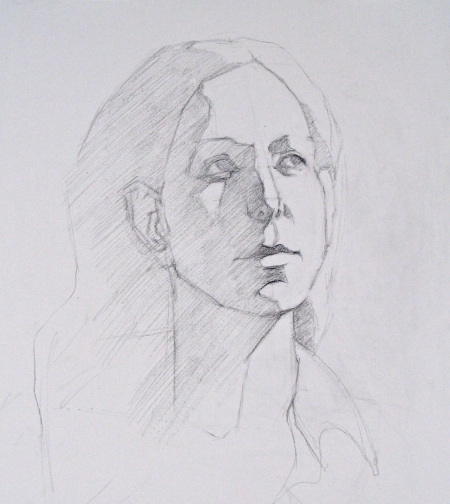
The recipe runs thus:
Step 1: Positioning the Major Intersections.

Start by marking down the center axis of the face, paying attention to the tilt.
Mark down the top of the head, and the bottom plane of the jaw. This doesn’t mean the point where light breaks on the chin, but rather the point where people get a second chin when they get a second chin.
Find the imaginary line running through the tear ducts. Books usually claim that it’s exactly half-way down the head, but it’s not. Books lie because they enjoy seeing you sweat.
Mark down the base of the nose, and the center line of the mouth (where the upper lip meets the lower lip).
Note the distances marked by the red arrows. Getting them right will go a long way towards a good likeness.
Step 2: Let There Be A Nose.

Set up a nose by finding the angle it comes down at, and by creating a trapeze-shape for the base plane. Note how much of the base you can see from your position.
Things to get right include the relative proportions of the top and the base, and how wide the nose is in both those parts.
Step 3: Sockets!

OK, this part can be tricky because sockets were designed to accommodate the eyeballs, and also to generate maximum confusion.
Try to locate the bridge of the nose first. There will usually be some helpful shadows where the plane changes from forehead bones to the nasal bone.
From there, find the top edges of the sockets. Check how high they are in relation to the nose bridge – this distance varies a lot from person to person.
Don’t be misled by the eyebrows. Sometimes they sit on the edge of the socket and sometimes they wander all over the place. Draw the socket first – you can plant the brows on it later.
Between the top edge of the socket, and the line of the tear ducts, you can start triangulating where the actual tear ducts are on that line. Check their relationship to the vertical lines of the nose and the widest point of the nose. If you draw an imaginary vertical line from the widest point of the nose, where do the ducts fall, to the right or to the left of it? How far?
OK, now you have the distance between the eyes. You can use it to measure the size of the eyes, and then mark down the outer edge of each eye. The socket forms an angle around there, which you can take back up to the upper edge of the socket. Hooray! Sockets! And a rough position for the eyes!
There is lots to finesse from there, once you get the position of the top and bottom of the eye. To get those, the tear duct line makes a good reference point. How far above and below it does the eye end?
Step 4: A Mouth Would Be Nice.

The mouth is easy. After the hellishness of the eye sockets, the mouth is a breeze.
The proportions to mind are the width of the center line, and the thickness of the top and bottom lips. To position the corners of the mouth, drop an imaginary vertical line from the tear ducts and from the outsides of the eyes.
Step 5: Triangulating The Ears.
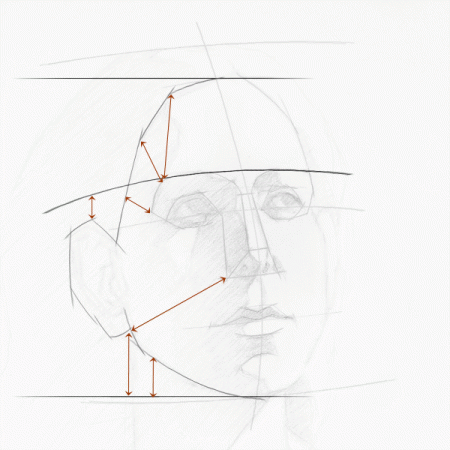
Oh boy. It’s not as difficult as mapping the sockets, but strangely enough, more eyeballing is involved.
Start with imaginary horizontal lines through the top of the hairline and the bottom of the chin. Map the hairline and the jaw angles, using the horizontal lines as a reference. See all the red arrows? The billion red arrows? Those are all visual comparisons and triangulation references. The jaw and the hairline have several highly visible changes of plane, and at those key points, you can look at the angles they are at, in relation to other key points.
This stage involves shuffling things around until they look right. I’m usually tempted to stab myself at this point, but not as much as during the Socket Stage.
OK. The angles are in place, and Martha Stewart, Queen of Precision, is no longer choking with laughter. Now we find the top and bottom of the ear. See the imaginary line running over the top of the eye sockets? That’s a good reference for the top of the ear. The bottom of the ear is at an angle to the nostril and it’s somewhere higher or lower in relation to the corner of the mouth.
Phew. That’s the ear. Making it ear-like is not too hard if you track the major changes in contour direction with straight lines, rather than try to match the curve with, for lack of a better word, curves.
From there it’s all coasting downhill with fun hair shapes. And then? Shadow shapes, laying in major values, doing some praying mantis kicks edge management, ooh, halftones and well, that’s a whole ‘nother post. Or seventeen. Which will be coming at some point!
Many thanks for Lisa Marie for her total mastery of stillness, and to Sang Bang for an informative and helpful class.,
